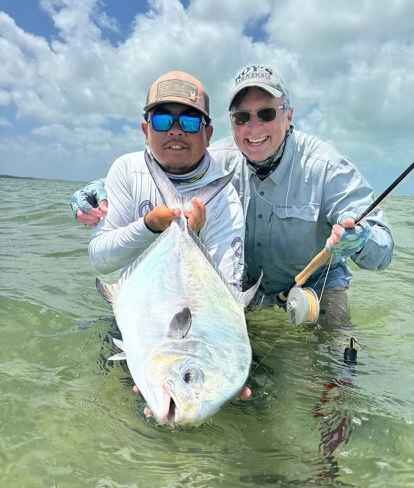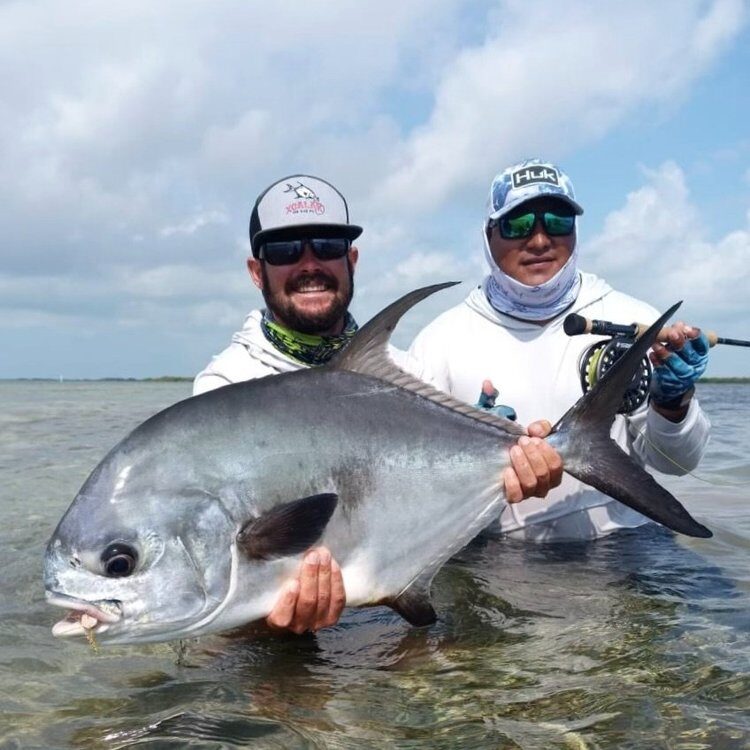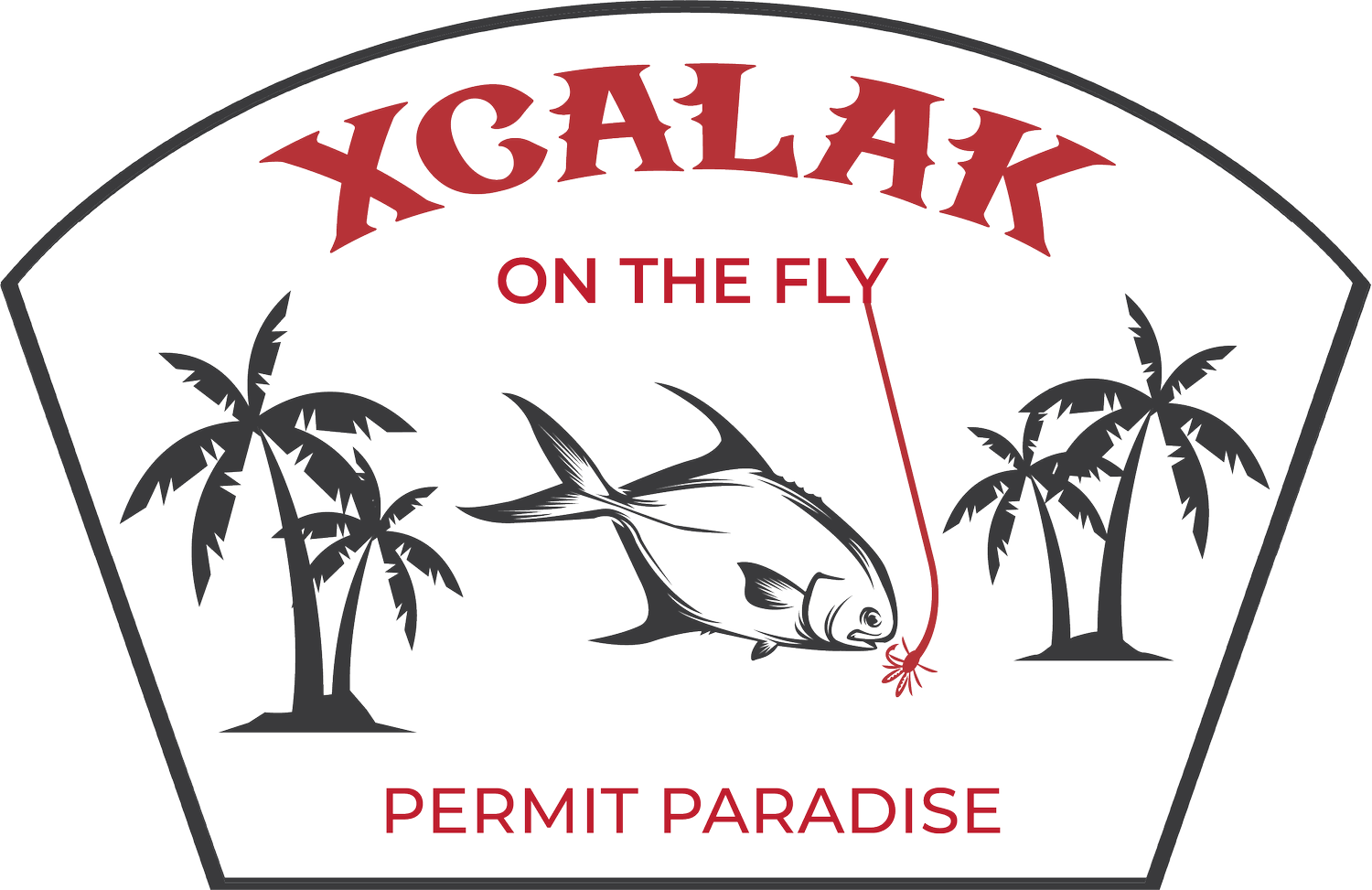
The Permit, the ultimate prize for saltwater fly anglers, is a thrilling challenge here in Xcalak. Their elusiveness, selective feeding habits, and sheer power make them a favorite among anglers—even featured in our logo! To increase your chances of success, it’s crucial to understand their life cycle and how it shapes their behavior on the flats.
The Permit Life Cycle
Permit begin life offshore, where adult fish gather in large spawning groups near reefs and drop-offs. Spawning typically peaks between late spring and early fall, often triggered by the lunar cycle and warm water temperatures. The lunar cycle, which affects the tides, and warm water temperatures, which are conducive to hatching eggs, play significant roles in the spawning process. The lunar cycle influences the tides, which in turn affect the movement of the larvae and the availability of food. Warm water temperatures are crucial for hatching eggs and the survival of the larvae. The eggs hatch into larvae, which drift with ocean currents, feeding on plankton. After a few weeks, the larvae transform into juvenile fish and move toward inshore habitats like seagrass beds, mangroves, and shallow flats.
These juveniles rely on shallow water to avoid predators and feed on small crustaceans, worms, and mollusks. As they grow, they expand their range and feeding habits, transitioning to sand and coral flats, where they hunt crabs, shrimp, and small baitfish.
Adult Permit continue to use the flats as feeding grounds but spend more time in deeper water when not foraging. Their strong molars and highly tuned senses Permit specialists to pick off prey hiding in sandy or grassy bottoms. Their growth to maturity typically takes 3–4 years, and they can live over a decade, making them cautious and deliberate feeders.

Using Their Life Cycle to Fly Fish Smarter
Here in Xcalak, the flats are prime territory for Permits year-round, but knowing their behavior during different life stages can significantly improve your fly fishing success.
1. Focus on the Flats for Feeding Fish
Permit frequent shallow flats to feed, especially during tidal movements. Rising and falling tides stir up prey like crabs and shrimp, drawing Permits to key areas. Flats adjacent to channels, coral heads, or drop-offs are ideal spots to find feeding fish. These areas provide a mix of shallow and deeper water, which is attractive to Permit. Study the tides and prioritize times when water movement is most active.
2. Match the Hatch
Permit are picky eaters, and their diet is tied to what’s locally available. Juveniles in seagrass beds often feed on shrimp, while adults on sandy flats prefer crabs. Successful anglers use realistic fly patterns that imitate these prey items. Merkin crab flies, spawning shrimp patterns, or tan mantis shrimp imitations are excellent choices here in Xcalak. Pay attention to the size and color of the crabs and shrimp in the area to refine your fly selection.
3. Timing is Everything
The warm, clear waters of Xcalak make for ideal Permit fishing conditions, but time of day can play a role. Early mornings and late afternoons often see Permit patrolling the flats, particularly during cooler parts of the day. On bright, sunny days, you’ll also have excellent visibility for sight fishing, which is crucial for targeting these wary fish. Sight fishing is a technique where you spot the fish before making your cast, allowing you to present your fly more accurately and increase your chances of a successful catch.
4. Perfect Your Presentation
Permits are cautious and often spook easily. A quiet, precise presentation is critical. Cast slightly ahead of the fish’s path, allowing your fly to settle naturally. A slow, deliberate retrieve mimicking a fleeing or burrowing crab often works best. Spend time practicing your accuracy—Permit demands precision.
5. Seasonal Considerations
While Permit can be found year-round in Xcalak, spawning behavior can influence their movements. During the warmer months, you might find more Permit closer to reefs and deeper flats as they prepare for or recover from spawning. At other times, they’ll focus heavily on the inshore flats for feeding.
The Reward
Understanding the life cycle of Permits helps you anticipate their habits, target their feeding zones, and approach them with the right tactics. While they’re undoubtedly one of the most challenging species to catch on the fly, the thrill of hooking into one on the stunning flats of Xcalak makes every effort worthwhile. Study their behavior, refine your skills, and prepare for the ultimate saltwater fly fishing adventure at Xcalak on the Fly!
